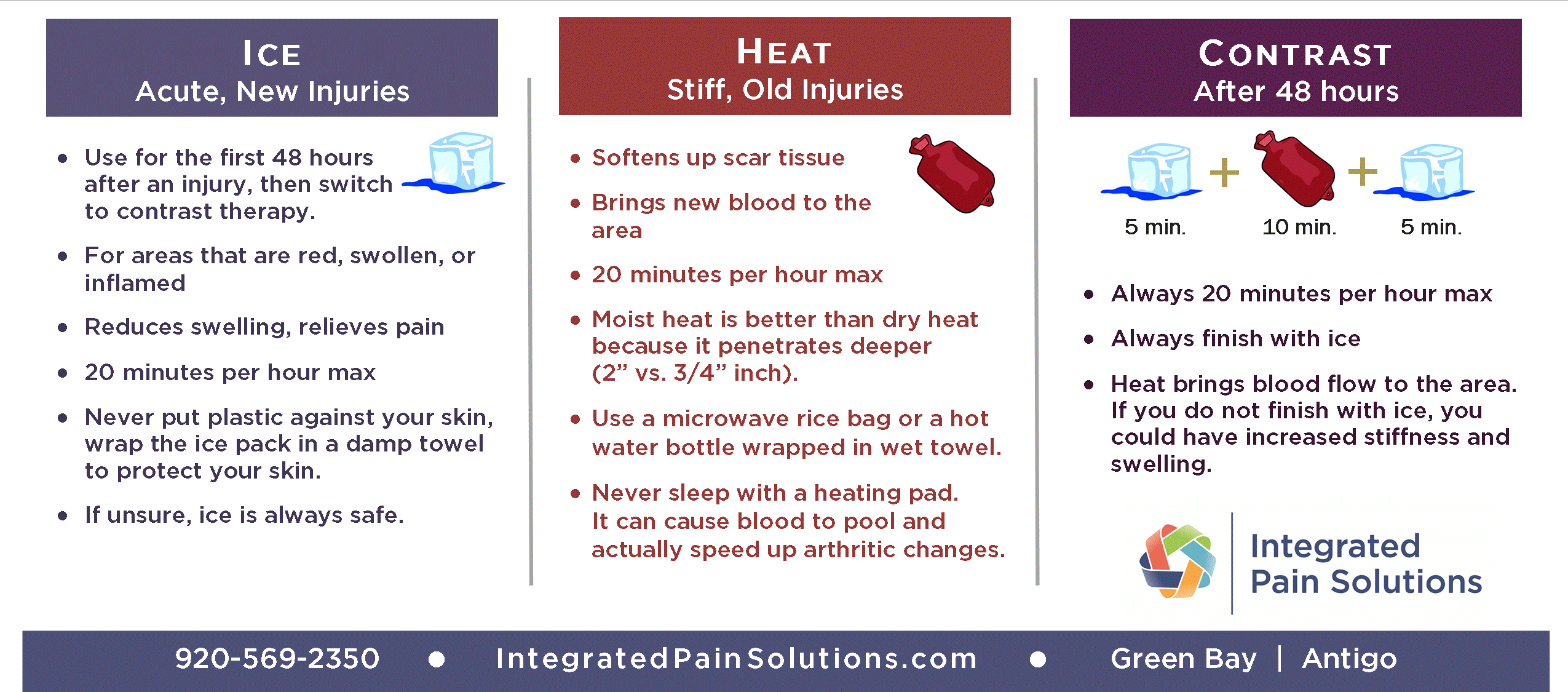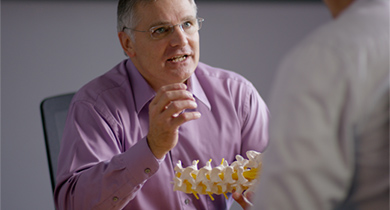LASER THERAPY CAN PROVIDE YOU CHRONIC PAIN RELIEF
Ice or Heat for Your Pain? That is the question
I encourage my patients to learn how to take care of themselves and treat their own aches and pains as much as possible, and if there’s one thing that continues to confuse people, it’s the proper use of ice or heat on injuries and pains. So, I’ll try to simplify it for you today.
Ice is for new injuries. Heat is for old aches and pains.
In fact, let me make it even shorter and easier to remember. Ice is for new injuries. Period. If you remember that much, you’ll be ahead of most other people.
Not only is it important to know WHICH therapy to use, but it’s equally important to know HOW to use each therapy. So, let’s review a little bit on each.
 ICE is for New Injuries
ICE is for New Injuries
Ice should be used for a new or acute injury. It is a cheap and effective way to ease the pain of most injuries. It works in two ways. First, it numbs the area. This will block the pain sensation to offer you some relief. Secondly, it reduces swelling or inflammation.
How do you know if it’s an acute injury? Surprisingly, that is not always an obvious answer. If the area is red, swollen, warm to the touch, or sensitive to touch, those are signs that the area could benefit from icing. Ice should be used for the first 48 hours after an acute injury. After that you should switch to contrast therapy (more on that below).
How to Properly Ice
One of the most effective ways to ice is with an ice cube itself, or by immersing the area in a bucket of ice water. This is because the area benefits not only from the ice itself, but the ice cold water will get into cracks and crevices that an ice pack cannot penetrate.
If you do use an ice pack, it is best to wrap it in a damp towel to protect your skin. You should never put ice cold plastic against your skin.
Ice for a MAXIMUM of 20 minutes per hour. Then take a break, and ice it again.
HEAT is for stiff, old aches and pains.
Heat helps to soften up the scar tissue that exists as a result of an old injury or a previous surgery. Scar tissue is formed in random, criss-crossing patterns, has poor circulation, and contracts when you sleep. Stiff, old scar tissue is not your friend. Heat also brings new blood flow to an area and with it fresh oxygen and other nutrients. Heat can also help to soften up trigger points (knotted muscles) and reduce stress.
How to Properly Use Heat
Moist heat is better than dry heat because it can penetrate much deeper into your muscles. Moist heat can get up to 2” deep as opposed to dry heat which gets less than 1” deep. I usually suggest using a hot water bottle wrapped in a damp towel or one of those microwave rice or bean bags. Heating pads will work, but they supply a dry heat, so they are not able to penetrate as deeply.
Just like with ice, you should only use heat for a MAXIMUM of 20 minutes per hour. Then take a break.
Also, NEVER sleep with a heating pad. Aside from the obvious fire issues, extended exposure to heat can cause blood to pool and can actually speed up arthritic changes in the body.
CONTRAST Therapy
In the case of a new injury, after the first 48 hours of icing, you should switch to what is known as contrast or combination therapy. That simply means to go back and forth from ice to heat and back to ice.
- Use ice for 5 minutes
- Switch to heat for 10 minutes
- Go back to ice for the last 5 minutes
As with ice and heat alone, this therapy should only be used for a maximum of 20 minutes per hour (5+10+5=20).
Always start with ice, and always finish with ice. Above, I told you that heat brings blood flow to the area. So, if you do not finish with ice, you could have increased stiffness and swelling in the injured area.
Finally, if you’re not sure whether to use ice or heat, ice is always the safer choice.
Here is a helpful chart that you can post on your fridge for the next time that you have an injury or pain.

More from Integrated Pain Solutions
- The Ugly Truth about Scar Tissue
- A Different Kind of Care for Chronic Pain
- High Intensity Laser Therapy
 Dr. Curt Draeger, DC, DACBOH, CCST is the treating doctor to Team USA’s Olympic decathletes, founder of Integrated Pain Solutions, and co-developer of the latest generation of High Intensity Therapeutic Lasers. His unique chronic pain treatment protocol provides lasting relief and healing to anyone suffering from chronic pain by combining High Intensity Laser Therapy with other manual therapies once reserved exclusively for professional athletes.
Dr. Curt Draeger, DC, DACBOH, CCST is the treating doctor to Team USA’s Olympic decathletes, founder of Integrated Pain Solutions, and co-developer of the latest generation of High Intensity Therapeutic Lasers. His unique chronic pain treatment protocol provides lasting relief and healing to anyone suffering from chronic pain by combining High Intensity Laser Therapy with other manual therapies once reserved exclusively for professional athletes.




